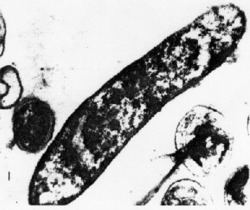Kingdom Bacteria Order Hydrogenophilales Higher classification Hydrogenophilales | Phylum Proteobacteria Scientific name Hydrogenophilaceae Rank Family | |
 | ||
Similar Bacteria, Proteobacteria, Betaproteobacteria, Halothiobacillus, Nitrosomonadales | ||
Dominio bacteria phylum proteobacteria 16 clase betaproteobacteria familia hydrogenophilaceae
The Hydrogenophilaceae are a family of Betaproteobacteria, with two genera – Hydrogenophilus and Thiobacillus. Like all Proteobacteria, they are Gram-negative. Hydrogenophilus species are thermophilic, growing around 50°C and obtaining their energy from oxidizing hydrogen.
Contents
- Dominio bacteria phylum proteobacteria 16 clase betaproteobacteria familia hydrogenophilaceae
- Medical vocabulary what does hydrogenophilaceae mean
- Obsolete Thiobacillus species
- References
Thiobacillus spp. can be used in pest control, such as potato scabs. If an affected area is treated with sulfur and Thiobacillus spp., the bacteria oxidise the sulfur to sulfuric acid, which destroys the pest, as the potato scabs cannot tolerate acidic conditions. Thiobacillus thioparus may contribute to the formation of acid rain through the oxidation of sulfur dioxide to sulfurous acid.
Hydrogenophilus thermoluteolus is a facultative chemolithoautotroph that previously had only been found in hot springs. However, it was isolated in 2004 from ice core samples retrieved from a depth around 3 km under the ice layer covering Lake Vostok in Antarctica. The presence of these thermophilic bacteria in the ice suggests that a geothermal system exists beneath the cold water body of Lake Vostok.
Medical vocabulary what does hydrogenophilaceae mean
Obsolete Thiobacillus species
The genus Thiobacillus was redefined to include only those species included among the Betaproteobacteria. Other member organisms once named "Thiobacillus" were transferred to Gammaproteobacteria:
